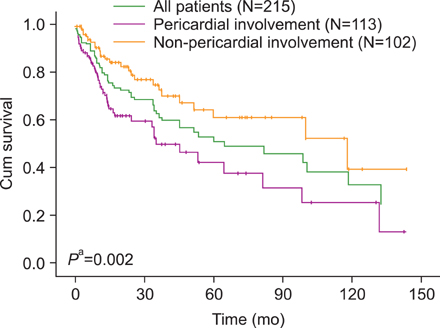Korean J Hematol.
2012 Sep;47(3):237-238. 10.5045/kjh.2012.47.3.237.
Prognostic relevance of pericardial effusion in patients with malignant diseases
- Affiliations
-
- 1Department of Laboratory Medicine, Asan Medical Center, University of Ulsan College of Medicine, Seoul, Korea. hschi@amc.seoul.kr
- KMID: 2251961
- DOI: http://doi.org/10.5045/kjh.2012.47.3.237
Abstract
- No abstract available.
MeSH Terms
Figure
Reference
-
1. Gornik HL, Gerhard-Herman M, Beckman JA. Abnormal cytology predicts poor prognosis in cancer patients with pericardial effusion. J Clin Oncol. 2005. 23:5211–5216.
Article2. Halfdanarson TR, Hogan WJ, Moynihan TJ. Oncologic emergencies: diagnosis and treatment. Mayo Clin Proc. 2006. 81:835–848.
Article3. Dequanter D, Lothaire P, Berghmans T, Sculier JP. Severe pericardial effusion in patients with concurrent malignancy: a retrospective analysis of prognostic factors influencing survival. Ann Surg Oncol. 2008. 15:3268–3271.
Article4. Kim SH, Kwak MH, Park S, et al. Clinical characteristics of malignant pericardial effusion associated with recurrence and survival. Cancer Res Treat. 2010. 42:210–216.
Article5. Maisch B, Ristic A, Pankuweit S. Evaluation and management of pericardial effusion in patients with neoplastic disease. Prog Cardiovasc Dis. 2010. 53:157–163.
Article
- Full Text Links
- Actions
-
Cited
- CITED
-
- Close
- Share
- Similar articles
-
- Quantification of Large Pericardial Effusion by Two-Dimensional Echocardiography
- Malignant pericardial effusion in carcinoma of the uterine cervix
- Pericardial effusion developed as Radiation-Induced heart disease(RIHD) in malignant lymphomas
- Two Cases of Primary HypoThyroidism Presenting with Pericardial Effusion
- Pericardial Effusion and Pericardiocentesis: Role of Echocardiography


